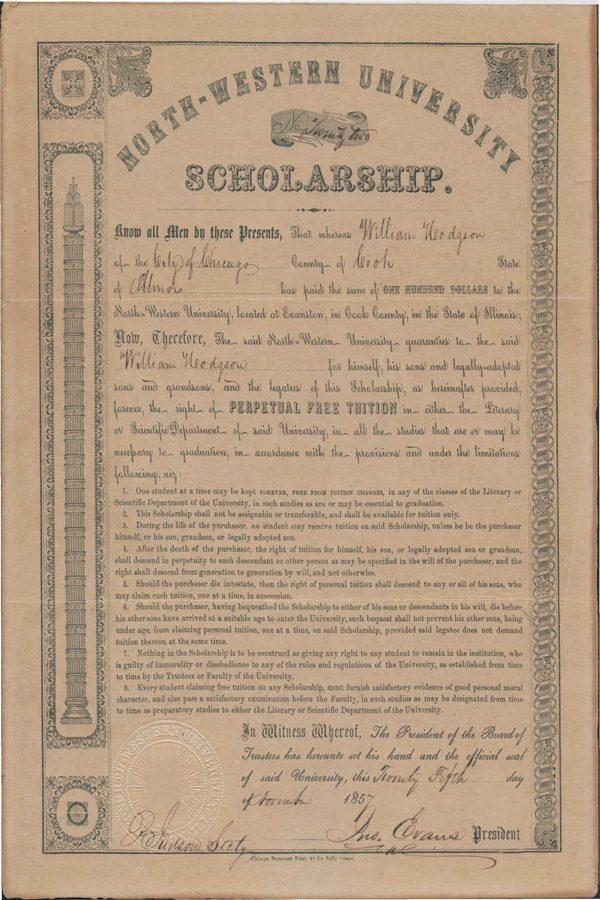After 150 years, free tuition grants at Northwestern still honored
Source: Northwestern University Archives
An original certificate for a perpetual scholarship. Perpetual scholarships were created when Northwestern was first founded to help finance the University.
February 22, 2017
When Northwestern was first looking for funding in the 1850s, it sold bonds guaranteeing free tuition for students. Today, the descendants of those original bond holders can still attend the university for free.
“Perpetual scholarships,” which guarantee free tuition to descendants of some of the original financiers of Northwestern, were common ways to raise money for budding universities in the antebellum era, said University archivist Kevin Leonard. Financiers could purchase bonds, lending Northwestern money, in exchange for tuition for them or their children. Initially, more than 1,100 bonds were sold to support NU, with approximately 340 including perpetual scholarships.
The bonds were one of three principal methods for financing the nascent Northwestern, along with donations from the Methodist community — NU was formally tied to the Methodist communion until the 1970s — and rent from University-owned land in Evanston.
Many scholarships were lost or invalidated over the years, Leonard said.
Both University spokesman Al Cubbage and Carolyn Lindley, director of financial aid, said they did not know of any students currently enrolled on the scholarship. Still, Northwestern continues to honor perpetual scholarships as long as they are still valid according to the original terms, Cubbage said. The Daily reported a student attending Northwestern on the scholarship in 2006.
“It’s an interesting kind of bit of historic trivia,” Cubbage said. “But it’s something Northwestern has honored throughout more than 150 years now.”
When the University first sold bonds, Northwestern was an all-male institution, and original certificates stated only men were eligible for the scholarships. Women were first admitted in 1869, and the scholarships were amended to be applicable for female students as well.
Perpetual scholarships do not guarantee admission, Leonard said, but when they were first issued, they may as well have. But as the University became more selective, maintaining a perpetual scholarship became increasingly difficult.
“At the time when these were sold, admission to college was you show up,” Leonard said. “There was not much to it beyond that. But at present, this is a very selective institution, so you still have to be admitted.”
Although some of the old certificates may pepper yard sales and collect dust in attics, finding one won’t guarantee free admission, Leonard said. Only those bequeathed the scholarship in an ancestor’s will can touch the benefits.
“If you see one for sale on eBay or on a garage sale, you purchase it and that invalidates the terms that make it a valid instrument that grants you tuition,” Leonard said.
The cost to attend Northwestern — including tuition, fees and housing — for the 2016-17 academic year totaled $70,496.
The original price for a perpetual scholarship: $100.
Email: [email protected]
Twitter: @matthewchoi2018


